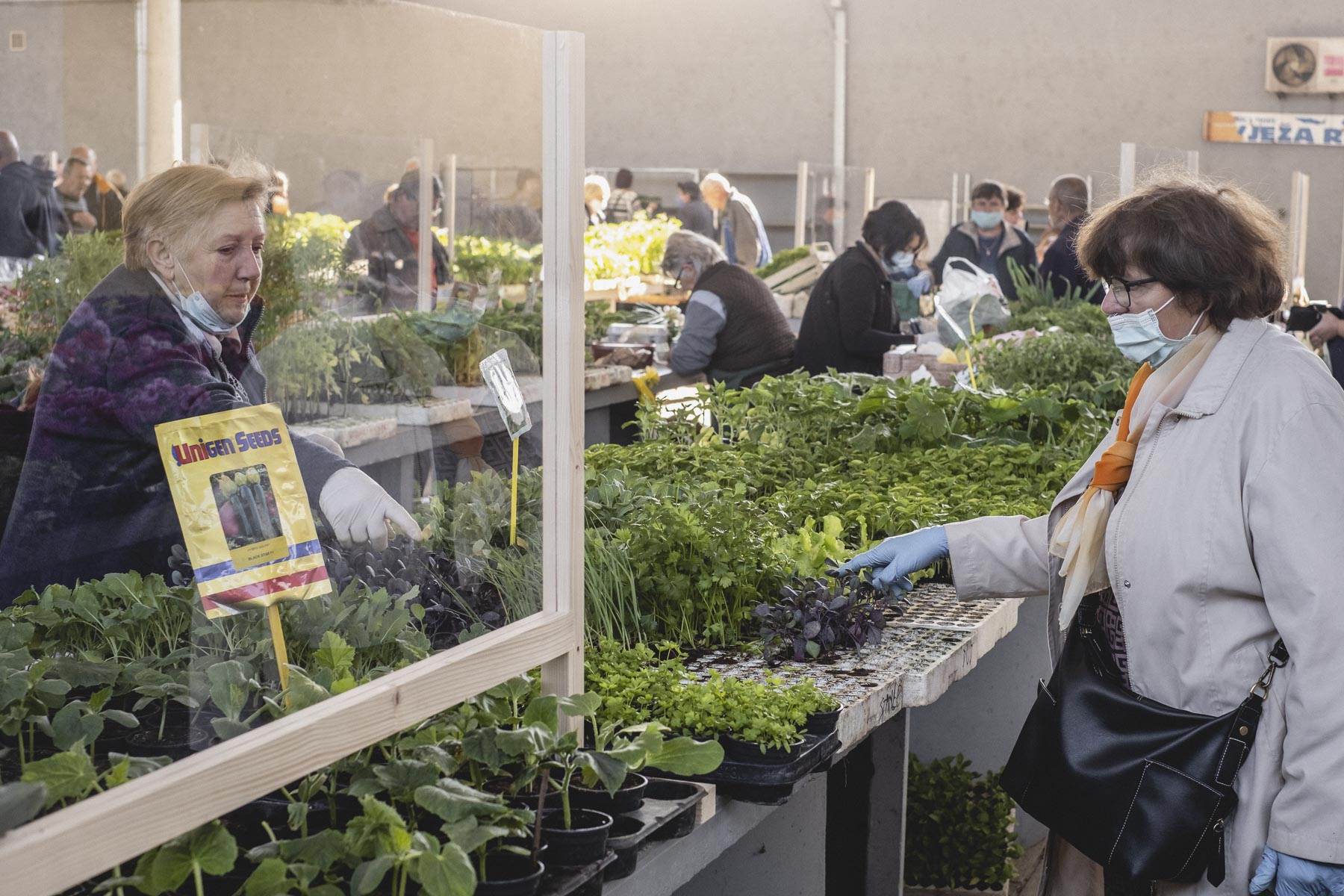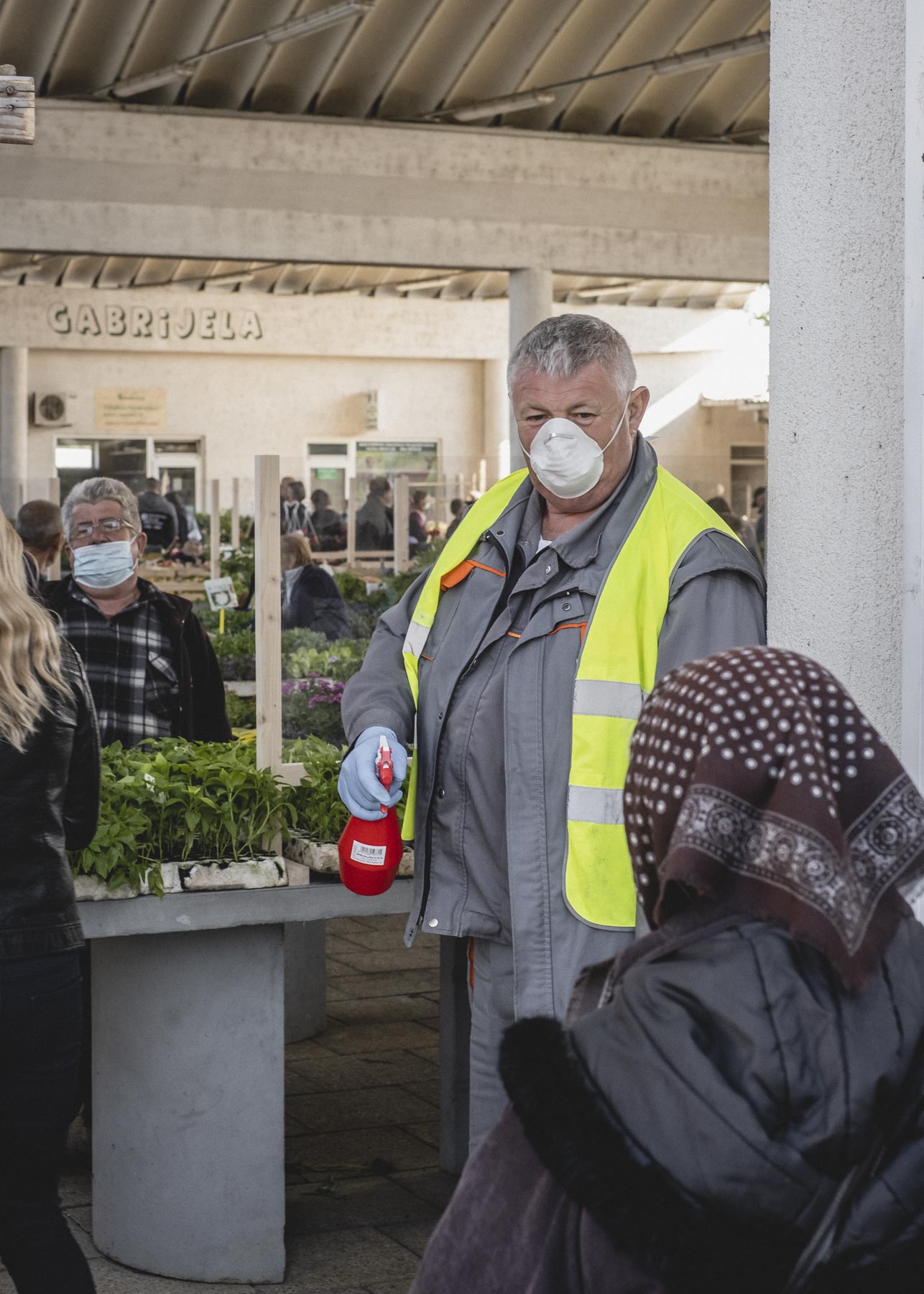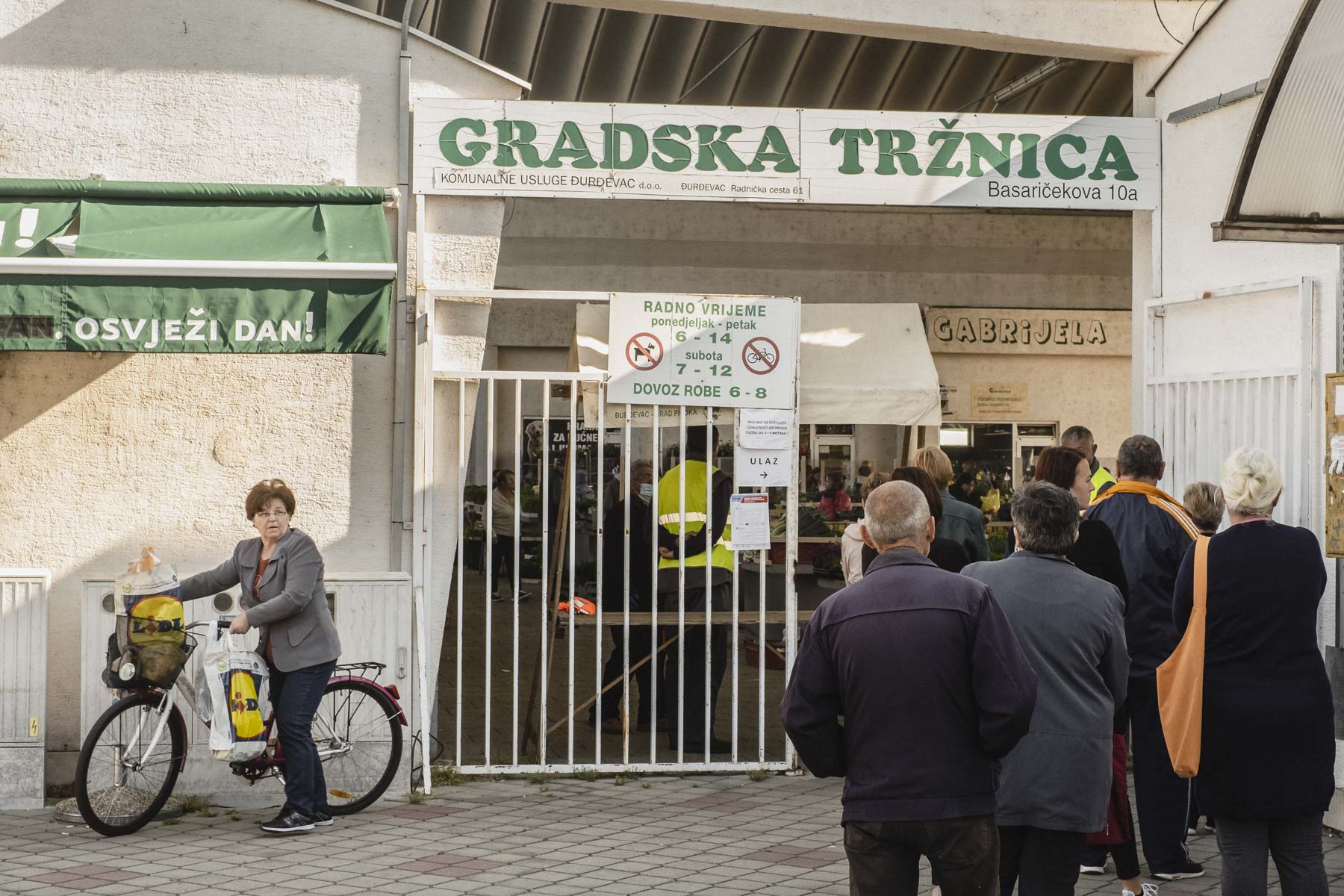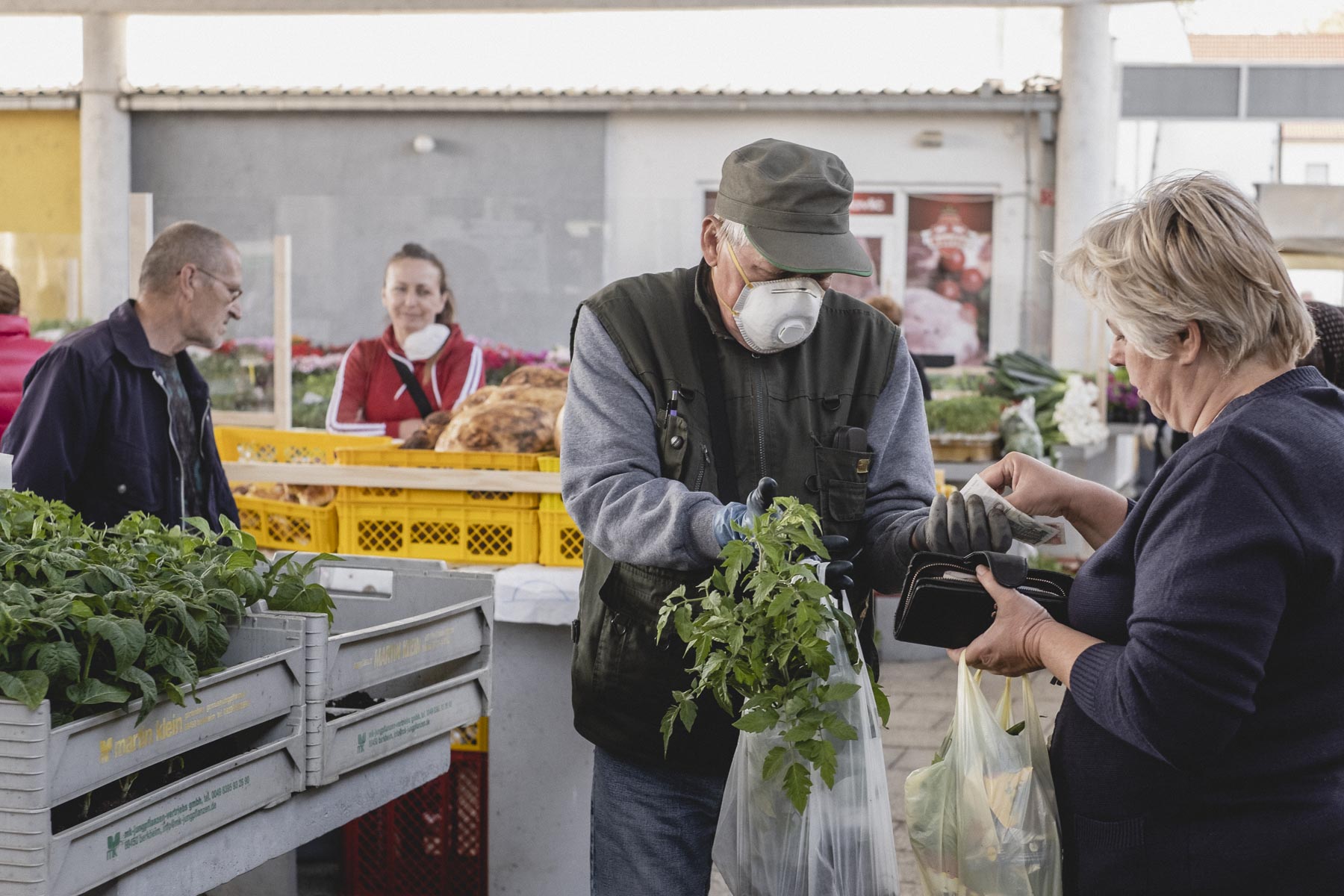Devastating Drought to Make for Difficult Winter and Spring
August 9, 2022 - This is one of the driest years, and according to the farmers, the drought has already caused a shortage of fruits and vegetables, including tomatoes, peppers, and potatoes.
As Glas Slavonije reports, In the heart of Slavonia, Croatia's open-air food factory, in Đakovo, compared to the 35-year average of 760 liters per year, so far in 2022, 190 liters of rain are missing. From the beginning of the year to the present day, according to the records of Bartolo Bačić, who monitors the weather conditions in Đakovo, only 261 liters of rain fell in this part of the country. “If it rains now, it's too late”, said OPG member Mato Kretonić from Budrovac, who sells the fruits of his labour from the garden with his wife every day at the Đakovo market.
The drought, which resulted in scorched earth, will not abate even in autumn, and farmers and vegetable growers are announcing large deficits in the production of corn, sugar beet, vegetables, fruit, etc., which will, of course, be reflected in the further increase in prices. At the city market in Đakovo, they have kept them at the level that arose after last year's jump. “The prices were not corrected, even though it was necessary, but if that had happened, I don't know who would have been able to sell their goods”, says Blaženka Škorvaga of the OPG from Punitova. Farmers do not have good news for the coming period.
“This is one of the driest years ever. I am a realist by nature, and I can say that in the coming time there will be little due to drought and other disturbances. What was hinted by experts a few months ago - that there will be a food shortage, is already visible now. A difficult period awaits us in winter and spring when it will be difficult to get food at all”, warns the vegetable farmer Kretonić.
“Peppers cost 12 kuna, potatoes 8, tomatoes 10, or 5 kuna in wholesale, cucumbers, onions and cabbage cost 8, carrots 10, pumpkins range from 5 to 7 kuna per piece, and a special kind of zucchini goes for 15 kn/kg”, Mata's wife Marica Kretonić lists the prices at her stand. A kilogram of yellow beans costs 50 kuna. These OPGs sell cooking corn for 3 kuna per piece. “Its quality is first class”, adds Marica. Keeping prices at (almost) last year's level, warns her husband Mato, puts them in an unenviable position.
“Next year, we practically won't be able to organise production, because there is no working capital”, says this OPG employee.
When asked if people are buying less because of price increases, or inflation, the answer is negative.
“People keep buying because they don't have their own products due to these extreme weather conditions, but shopping for winter food is also declining this year, and people are also losing the habit of preparing it. They used to buy it by the bag, but now people only buy ten heads of cabbage for pickling”, says Budrovčanin.
And the vegetable gardener Škorvaga warns that there will be a shortage of food soon.
“There is a shortage already. There will be a lack of tomatoes, peppers, potatoes... There is a lack of fruit, you can see which fruits are local, because they are much smaller, and which are imported. And customers are aware that food production is like that, the products are worse because of the drought, and they understand”, says Škorvaga, whose production has been suffering for two years due to the capricious nature, storms - last year the wind destroyed her greenhouses, and this year the ice beat the seedlings, counting 300,000 plants. Damage - HRK 100,000.
Production to be cut in half
“I will cut production in half. I can no longer sustain such a large production. Nature can be compensated, but it is too expensive to be marketed, and there is also a high cost of labour and its lack”, says Škrovaga. At her stand, tomatoes cost 10, or 4 kuna in wholesale, peppers 10, corn 2 kuna a piece, melon 7, cucumbers 8 kuna. A kilogram of green beans costs 25 kuna, and half a kilogram 15 kuna.
“People are less likely to buy vegetables for the winter. They say they will eat what they have. Purchases at the market have decreased, and many people do not come anymore especially young people”, says Škorvaga.
A liter of tomato sauce at the market in Đakovo on Saturday cost 20 kuna. The price of the queen of summer fruit - watermelon - at the stand of Marina Grgić from Đakovo cost 3 kn/kg. The vegetable farmer says that she will be ready for the dry autumn - with deep wells.
While more retailers are already dually reporting prices, there are still no buyers' inquiries on the market about the formation of prices in euros, according to our interlocutors. “Everyone is still silent about it”, says Marica Kretonić, and her husband Mato adds that he will price his products in euros based on his own assessment.
“If I have my own goods, so that I don't have to resell them, there will be no price shocks with the switch to the euro. It will be rounded to Eurocents - for example, something that comes up to 63 will be rounded to 70 Eurocents”, says Škorvaga and adds: “Some things will be rounded to my detriment, some to the detriment of the customer”.
For more, make sure to check out our Lifestyle section.
Total Value of 2020 Real Estate Market Transactions Up 0.5% to HRK 40bn
ZAGREB, 9 July 2021- In 2020, there were 103,000 transactions on Croatia's real estate market, or 7.7% fewer than in 2019, probably due to the COVID-19 pandemic to some extent, however the total value of real estate reached HRK 40 billion, 0.5% higher than in 2019.
The value of real estate transactions was equivalent to 11% of Croatia's Gross Domestic Product, and these figures were outlined at a news conference held in Zagreb on Friday on the occasion of the presentation of the annual publication "Croatia's 2020 Real Estate Market Overview", prepared by the construction and physical planning ministry and the Zagreb Institute of Economics (EIZ).
The ministry's state secretary, Željko Uhlir, said the residential real estate segment had the largest share in the market in terms of value of transactions, however most transfers were on the market of farmland and construction land and plots.
Every one in three transactions (33.3 %) were on the farmland market, and 16% of all transactions were sales of construction land.
Commenting on price rises, Ivana Rašić of the EIZ said that in 2020, the biggest increase in prices when it came to the real estate market were registered in the Adriatic counties of Croatia and in the capital city of Zagreb.
"The median flat price per square metre for the whole of Croatia was approximately HRK 9,600 in 2020," she said.
In Dubrovnik, for instance, the median flat price was HRK 19,000 per square metre and in Zagreb about HRK 11,000, she added.
Demand for new residential properties rose across the country, however houses in Zagreb, Split Rijeka, Pula and in their environs were also in high demand, Rašić said.
For more on business, CLICK HERE.
Members of Parliament Hope For Revival of Capital Market
ZAGREB, 26 May, 2021 - Amendments to the Capital Market Act, which are aimed at further aligning Croatia's regulatory framework with the EU acquis, were supported on Wednesday by both the Opposition and the ruling majority in the parliament, who expressed hopes for the revival of the capital market.
This is one of the most complicated laws that summarises what kind of capital market Europe wants, said Social Democrat MP Boris Lalovac, warning that Croatia's capital market was far less developed than the European.
"The value of the capital market in Croatia is HRK 276 billion, 140 billion are stocks and 130 billion securities, the annual turnover of the Zagreb Stock Exchange is around HRK 3 billion while the turnover on the OTC market is HRK 27 billion," Lalovac said.
That shows that outside of the stock exchange and capital markets, which have strict rules, trading is ten times greater, Lalovac said, expressing hope this would change.
Grozdana Perić of the HDZ said that better oversight and regulation would enable further development of the capital market in Croatia.
She warned, however, that the coronavirus crisis had caused an outflow of funds from investment funds and that their value had dropped by more than 35% or HRK 8 billion.
That is one of the reasons for amending the law, said the State Secretary at the Finance Ministry, Stjepan Čuraj, who presented the amendments to MPs.
"If we take as an example the Zagreb Stock Exchange alone, during the pandemic in 2020 it dropped by more than 35%, from 2,000 to 1,300 basis points," Čuraj said, noting that there was room for improvement.
For more about politics in Croatia, follow TCN's dedicated page.
Croatian National Bank: "45% of Croatia's Citizens Support Euro Adoption"
ZAGREB, 19 March, 2021 - The percentage of Croatian citizens who support the adoption of the euro in February this year has reached 45%, up by four percentage points from 41% in a previous survey, conducted in March 2020, the Croatian National Bank (HNB) said on Friday.
The fourth public opinion poll on the adoption of the euro was carried out for the HNB by the Ipsos agency from 23 February 2021 to 1 March 2021.
Nineteen percent of citizens are against the adoption of the euro, while 26% are either against or in favour depending on other factors, and 10% of the respondents do not know, the HNB said.
Also, they said, an increasing number of citizens think that the effect of the euro will be positive. Some of the advantages they see include easier payment and business, as well as the fact that the euro is the common currency in the euro area, which would make Croatia equal to other members of the monetary union.
On the other hand, they see a decline in the standard of living and purchasing power as the main risk, and over a third of citizens think that the adoption of the euro will further increase prices.
To date, the poll has been carried out four times: in August 2018, in February 2019, in March 2020 and in February 2021. The survey is conducted on a nationally representative sample of 1,000 respondents, aged 18 to 79, using computer-assisted telephone interviewing (CATI), and it covers four thematic units: the use of the euro in the Republic of Croatia by foreign citizens, how informed citizens are on the adoption of the euro, citizens' attitudes to the adoption of the euro and their expectations.
The aim of the survey is to determine whether Croatian citizens support the strategic commitment of the government and the HNB to adopting the euro as the official currency in Croatia and whether they are aware of all the benefits that the adoption of the euro will bring to them and the national economy.
For more about business in Croatia, follow TCN's dedicated page.
Croatian Hoteliers' Revenues Dropping 25-75%, Recovery Expected in 2 or More Years
ZAGREB, Oct 7, 2020 - Croatian hoteliers expect this year's revenues to drop 25-75% due to the COVID pandemic and half believe recovery will take two or more years, with holiday tourism expected to recover faster and convention tourism much slower, a director in the Horwath HTL consulting company says.
Such findings come from the company's analysis of the so-called COVID year in which the pandemic has affected every industry around the world, notably tourism.
Sinisa Topalovic says the forecasts for 2021 and the growth of the global GDP are somewhat encouraging, but that recovery by country will depend and be faster if they are industrially strong, while being harder and slower in those focused on services such as Croatia.
Global and country forecasts say consumption is expected to recover in 12 to 24 months, which is a very long time, notably in tourism, which has been globally affected by the pandemic, from air travel to the hotel industry, which are recording drops in revenues from 60% to 80%, and they will not recover soon, says Topalovic.
Croatia at EU's bottom in hotel occupancy but near the top in prices
In such circumstances, Croatia managed to generate above-average results when compared with the competition in the first eight months of the year, about 40% of last year's turnover, but next year could be at least 10 to 20 percentage points better, also thanks to this year's experience, according to a Horwath HTL analysis.
Croatia's average hotel occupancy rate in the first eight months of this year was 24%, ranking it at the bottom of the EU, but in terms of prices it ranks relatively high because during the short summer holiday season Croatian hoteliers managed to keep relatively good prices, which is good given that after being lowered due to the 2008-09 crisis, they took a long time to recover, says Topalovic.
Three markets saved the season
The analysis shows that only three markets, of the more than 70 from which tourists came to Croatia in the past, saved this year's season, generating up to 60% of the total turnover - Germany, Croatia, and Slovenia.
Croatian tourists "gave life to numerous destinations" and their arrivals and overnights registered the smallest decreases from the record year 2019, the analysis says.
For the latest travel info, bookmark our main travel info article, which is updated daily.
Read the Croatian Travel Update in your language - now available in 24 languages
AD Plastik Wins Golden Key Award As Best Large Exporter
ZAGREB, Sept 8, 2020 - Plastic car parts manufacturer AD Plastik wins Golden Key Award as the best large exporter in 2019, IT firm Infobip is the best medium-sized exporter and Jadran-una has been honored as the best small company, it was announced at the 15th Croatian Exporters Convention on Tuesday.
Addressing the convention, Prime Minister Andrej Plenkovic congratulated the exporters, saying that commodity exports had been rising steadily for the past 10 years and their share in GDP had increased from 16.7% to 28.5%.
He said that only 15% of Croatian companies generated revenues on foreign markets, while they employed 51% of the active workforce. He added that these companies place over 60% of their investments in research and development, generating three-quarters of total profits and nearly four-fifths of total investment in research and development in Croatia.
Speaking of boosting the export-oriented industry, Plenkovic cited reindustrialization and strong support to enterprises in using smart and clean technologies, greater use of energy from renewable sources, and digital transformation.
"That is the path to increasing competitiveness," the prime minister said, adding that the government's focus would be on developing sectors with great growth potential such as information and communication technologies, pharmaceuticals, biotechnology, pure technologies, such as solar and hydrogen, and new technologies, including 3D printing, nanotechnology, and robotics.
He also pledged further investment in education, railways, and broadband internet infrastructure.
"Our ambition is to create 100,000 jobs over the next four years, that is before the end of our term," Plenkovic said.
He highlighted two objectives of importance for exporters - the adoption of the euro and entry into the Schengen area.
The backbone of the Croatian economy
The head of the Croatian Exporters Association, Darinko Bago, praised the government for how it was handling the crisis caused by the global coronavirus pandemic, citing the government's social sensitivity and efforts to preserve jobs and help the tourist industry.
"Exporters are the best that Croatia has, they are the backbone of the Croatian economy," Bago said, adding that exporters expected the government to continue to be socially sensitive, but also to intensify localization and regionalization.
For the latest travel info, bookmark our main travel info article, which is updated daily.
Read the Croatian Travel Update in your language - now available in 24 languages
Croatia's Plum Production Falling, Imports Rising
ZAGREB, Aug 26, 2020 - Plums are increasingly in demand in the EU, however, Croatia's results in growing this fruit oscillate, as plum growing is often affected by weather conditions as it was this year, hence imported plums are dominating the market, an analysis by the Smarter consulting company said on Wednesday.
According to Smarter, which specializes in agriculture and food industry consulting, problems in the production of plums over the past few years have led to many large producers backing out of this business.
Croatia's plum production has recorded significant oscillations in recent years, Smarter underscored, supporting its claims with figures saying that in 2018, a record high 14,487 tonnes were produced whereas in 2014 just over 8,000 tonnes were produced.
This year due to poor weather conditions, the plum crop is expected to be quite bad, Smarter said and added that currently, the offer for plums is good however "the market is dominated by imported plums."
Smarter added that Serbia produces about 500,000 tonnes of plums annually and Bosnia and Herzegovina's plum crop is between 150,000- 200,000 tonnes. Romania too produces about 500,000 tonnes of plum annually and in 2018 its plum crop was a record high, 830,000 tonnes.
Data from the State Bureau of Statistics (DZS) indicate that back in 2008, Croatia produced 48,614 tonnes of plums with more than 32,000 being for its own needs through extensive cultivation while in 2019 production was only 9,403 tonnes," Smater's Miroslav Kuskunovic said.
According to official data, plums are cultivated on 4,500 hectares mostly in Slavonia and Baranja.
Last year 2,535 tonnes of fresh plums were imported with a value of €1.5 million while the country exported 845 tonnes for only €540,000.
Most imported plums came from Serbia (913 tonnes), Moldova (619 tonnes), North Macedonia (427 tonnes) while last year Croatia export 389 tonnes of plums and 57 tonnes of prunes.
At the same time, Croatia imported almost one thousand tonnes of prunes valued at €2 million, two-thirds of which were imported from Chile and Serbia.
Smarter underscored that European analyses indicate that the plum is one of the fruits with the most prospects for exporting in Europe and its market value in the EU exceeds €300 million.
For the latest travel info, bookmark our main travel info article, which is updated daily.
Read the Croatian Travel Update in your language - now available in 24 languages
Market vs. Social Distance? Đurđevac says: Market With Social Distance!
May 8, 2020 - Markets are sources for many people when it comes to fresh vegetables, fruits, milk, cheese, and much more. So, how is the market in Đurđevac coping in the second week of reopening?
Visiting markets is a part of the weekly, maybe even daily routine for a large number of people. While many markets needed to close their gates due to measures, people were left not only without fresh food but maybe without the familiar faces of their favorite sellers.
The market in Đurđevac used to be open every Thursday, and as one of the locals said: "This must have been difficult for them during this period of the pandemic, especially because the beginning of spring brings many more customers that buy plants for their personal gardens."

Joubert Loots visited the market in Đurđevac and told us information about every measure this market took. Besides the fact they had dedicated entry and exit points, the number of people inside was monitored - just like in every other store lately.

Most of the stalls had sneeze guards installed for added safety so you can sanitize your hands on every corner.

Maybe one of the best indicators that people from Đurđevac were missing their market was a long queue outside the market area.

Although most people are still equipped with masks, gloves, and sellers with a partition between them and customers, life is slowly returning to normal.
Many thanks to Joubert for the submission. You can check out his portfolio of photography here.
Are you a small business in Croatia, which has just reopened after the recent lockdown? TCN is happy to support local businesses promoting their stories. If you are interested, please send photos, your experience, and your website to This email address is being protected from spambots. You need JavaScript enabled to view it. Subject Small Business.
For the latest news on COVID-19 in Croatia, follow the dedicated TCN section.
First Electronic Croatian Fish Market Opened!
Meet BuyFish Shop, the first electronic fish market in Croatia.


